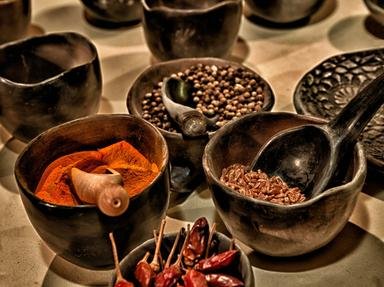Quiz Answer Key and Fun Facts
1. 'Apium prostratum', a coastal plant whose leaves were eaten as a vegetable by Captain Cook to help prevent scurvy in his crew, is also used as a flavouring agent in soups and stews. Its common name suggests that it tastes like its European relative, 'Apium graveolens', whose stalks, feathery leaves and seeds are used in a similar fashion. Which of these is it?
2. 'Atriplex nummularia', or Old Man Saltbush, is a grayish-blue shrub that grows well in dry and saline soils. As well as being used as food for grazing animals, the dried leaves and seeds can be used to replace which traditional flavouring agent?
3. 'Alpinia caerula' has lovely blue berries, with a lemony flavour. The plant's common name, however, suggests that it should taste like the rhizome of 'Zingiber officinale', an aromatic spice widely used in Asian cuisine. By which of these names is it commonly known?
4. Ringwood, an Australian rainforest tree, has an alternative name that reflects the flavour of an oil that can be extracted from its leaves. This oil is also found in the leaves of tarragon and fennel, among other plants. What is the more revealing name of this tree?
5. 'Eucalyptus dives (piperitone)' is grown commercially to be a source of the ingredients for producing artificial menthol. The leaves were traditionally added to a brew of billy tea in the Australian outback. By what name is it more commonly known?
6. 'Tetragonia tetragoioides', or Warrigal greens, are commonly eaten as a leafy vegetable. One of its other names reveals the European vegetable for which it was found to be a suitable substitute. By what name is it also known?
7. The leaves of one subspecies of 'Backhousia myrtifolia' contain elemecin, one of the main flavour ingredients in nutmeg. The dried leaves are often added to fruit-based dishes. Which of these is its common name?
8. The mountain pepper, 'Tasmannia lanceolata', grows abundantly in which of these southern Australian states?
9. The fruity condiment sold as forestberry herb comes from the leaves of 'Eucalyptus olida'. What is the more common name appetising for this eucalypt?
10. Australia's national flower is the golden wattle, 'Acacia pycnantha'. This picture shows a related species, 'Acacia aneura', which is commonly used in cooking. Which part of the plant is ground to make flour, and used whole as a flavouring ingredient in sauces and ice cream?
Source: Author
looney_tunes
This quiz was reviewed by FunTrivia editor
WesleyCrusher before going online.
Any errors found in FunTrivia content are routinely corrected through our feedback system.


